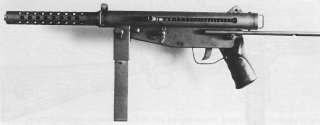Portuguese FBP Submachine Gun: More Than a Copy of the German MP40
As Portugal remained neutral throughout World War II little progress occurred until the hostilities ended.
A lot of firearms look alike, and it is easy to see how one successful firearm may have influence subsequent designs. Such is the case with a widely used submachine gun from the early Cold War era, and one that proved reliable in the harsh conditions of Africa for more than thirty years.
Visually the Portuguese FBP is similar to the German MP40 and American M3 “Grease Gun,” but in fact, the weapon was actually developed from a design that originated before the outbreak of World War II in the early 1930s. However, the actual development of the submachine gun began to move forward in 1940 at the Portuguese arms factory Fabrica de Braco de Prata under a team lead by Major Gonçalves Cardoso, an officer of artillery in the Portuguese Army.
As Portugal remained neutral throughout World War II little progress occurred until the hostilities ended.
Thus it was only in 1948 that Cardoso’s concept was refined as the FBP m/948—and by then it did take features from those two aforementioned weapons, notably the bolt and return spring setup and safety of the German design and the receiver along with trigger and shoulder stock of the American weapon.
The newly designated FBP used a simple blowback action that originally only offered fully automatic fire. This is due to it utilizing a near copy of the German MP40’s external telescoping bolt and return spring, but it also utilized a stamped steel receiver and it is easy to see that the telescoping steel wire buttstock was identical to the U.S. M3.
However, despite the similarities to the American Grease Gun, it was actually a far more reliable weapon, and more importantly, FBP offered a reasonable rate of fire of around five hundred rounds per minute, a bit higher than the M3. It also was chambered for the commonly used 9 x 19-millimeter Parabellum round that was found in so many World War II and Cold War-era submachine guns. Like both the MP40 and M3 the original FBP, which fired from an open bolt, was full-automatic only.
An upgraded version of the Portuguese submachine gun, which was designated the FBP m/963, was introduced in 1961 and it offered selective fire. However, the two versions also differ in the fact that only the original m/948 version was fitted with a barrel sleeve that allowed it accept the standard Portuguese Mauser bayonet—and it remains one of only a handful of post–World War II submachine guns that could be used with a bayonet, the Uzi being another.
It is worth noting that by 1980 the Portuguese military ceased production and adopted the Uzi instead, although the capability to use a bayonet likely had little to do with that eventual decision to replace the FBP, which had seen service in the Portuguese Colonial Wars in Angola and Mozambique where in jungle fighting such an “accessory” was truly unnecessary.
The FBP wasn’t the only Cold War submachine gun to take prominent features from notable World War II small arms, as the Belgian designed Vigneron also “borrowed” extensively from the MP40, M3 and even the British Sten Gun. What is notable too is that both the FBP and Vigneron were used almost exclusively in African colonial wars of the 1960s and 1970s—and due to shortages of the FBP the Portuguese Army purchased Belgian surplus stocks and the two similar weapons were used side-by-side in the largely futile efforts for those nations to retain the last vestiges of their colonial empires.
Peter Suciu is a Michigan-based writer who has contributed to more than four dozen magazines, newspapers and websites. He is the author of several books on military headgear including A Gallery of Military Headdress, which is available on Amazon.com.

